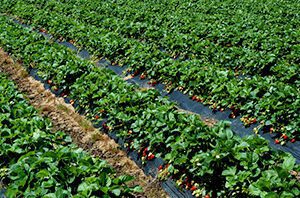For Immediate Release: Aug 14, 2014
Contact: Paul Towers, PAN, 916-216-1082
 Sacramento, Calif – In a letter submitted earlier today, farmworker, environmental health and justice organizations called on California officials to institute new protections for children from an increasingly widely-used and difficult-to-control pesticide, chloropicrin. Use of this chemical is especially on the rise in the state’s strawberry fields.
Sacramento, Calif – In a letter submitted earlier today, farmworker, environmental health and justice organizations called on California officials to institute new protections for children from an increasingly widely-used and difficult-to-control pesticide, chloropicrin. Use of this chemical is especially on the rise in the state’s strawberry fields.
The letter suggests that Latino schoolchildren continue to be disproportionately exposed to hazardous pesticides despite an earlier legal settlement. And fumigant pesticides like chloropicrin are of particular concern:
“EPA made a ruling of racial discrimination when considering that Latino schoolchildren were disproportionately exposed to methyl bromide. As the use of methyl bromide went down, chloropicrin use increased significantly. Both federal and state law protects Latino schoolchildren from discriminatory exposure to all pesticides, including but not limited to the heavily applied chloropicrin.”
Overall, use of chloropicrin has more than doubled in the past decade, from 4.2 million pounds in 2002 to 9.0 million pounds in 2012. And a recent report by the California Department of Public Health found it to be the pesticide most likely to be used in close proximity to California schools.
The letter penned by Californians for Pesticide Reform, the Center on Race Poverty and the Environment, California Rural Legal Assistance Foundation, Central Coast United for a Sustainable Economy, Central California Environmental Justice Network, and Pesticide Action Network comes as the California Department of Pesticide Regulation considers restrictions on the pesticide and as children’s health advocates continue to push for a phase-out of fumigants by 2020.
Paul Towers, a spokesperson for Pesticide Action Network and signatory to the letter said:
“As pesticide products used in strawberry fields change, the burden hasn’t. California’s Latino schoolchildren continue to face greater exposure to hazardous pesticides, including cholorpicrin. California policymakers must create better protections for children as they help farmers transition to green, cutting-edge solutions to hazardous pesticide fumigants.”
###







